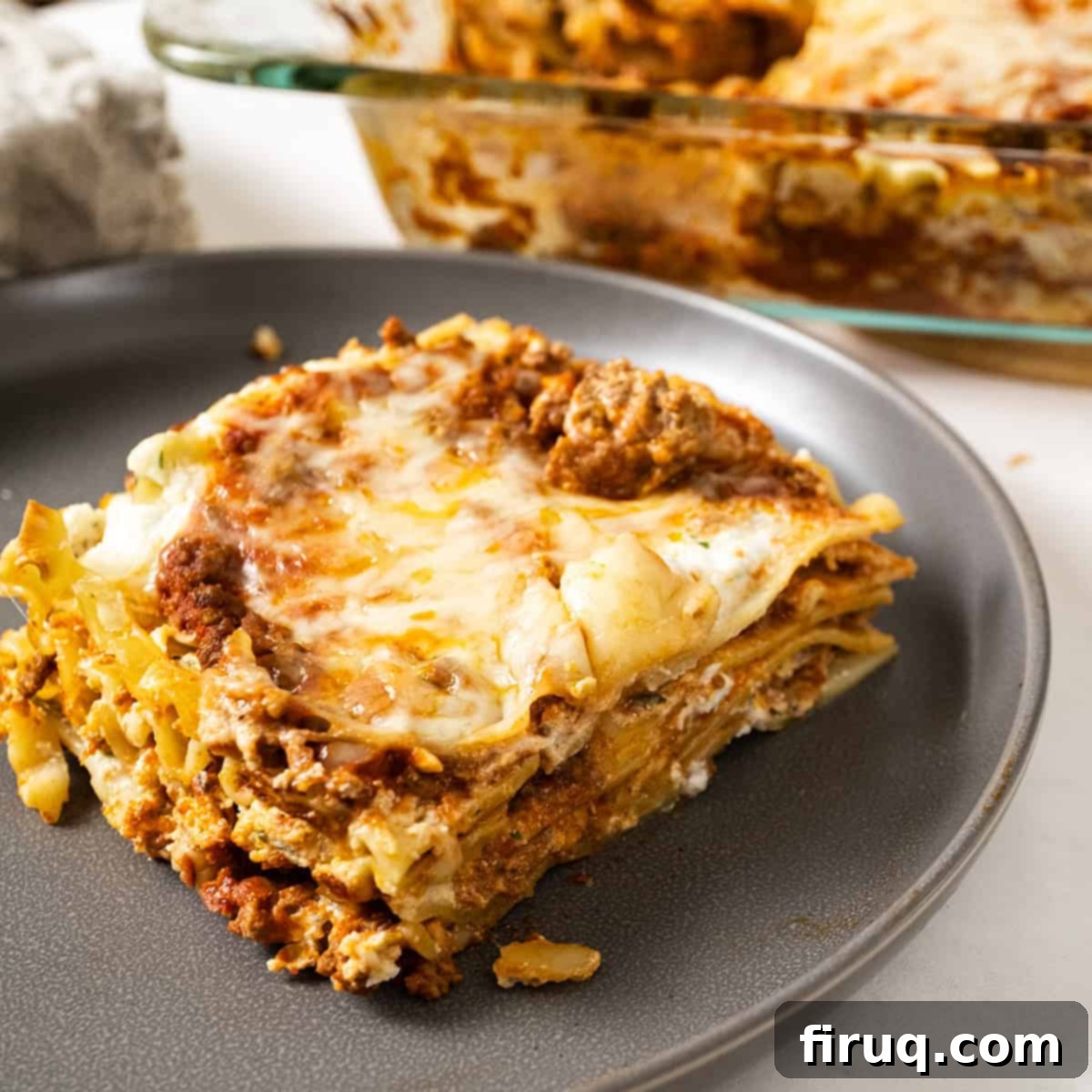The Ultimate Authentic Italian Lasagna Recipe: A Timeless Family Tradition
There’s nothing quite like a steaming plate of authentic Italian lasagna to bring a family together. In our Italian-American household, this beloved dish isn’t just food; it’s a cherished tradition, gracing our tables during all major holidays and special occasions. This classic Italian masterpiece is meticulously crafted with perfectly al dente lasagna noodles, a rich, savory ragù (meat sauce), and a beautifully seasoned ricotta cheese mixture. It’s a culinary hug that embodies comfort, flavor, and generations of love.
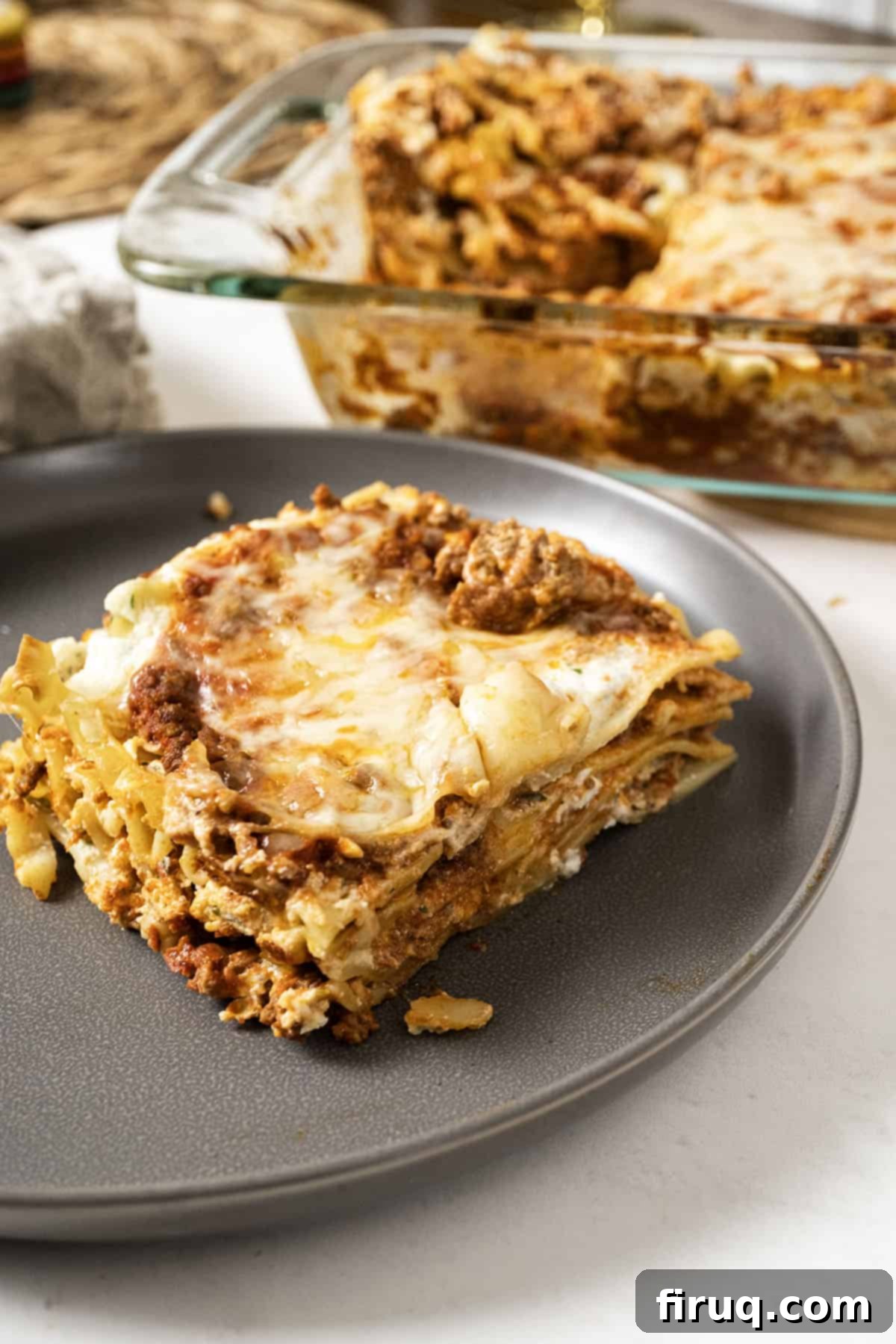
If you’re looking for more comforting baked Italian dishes, don’t miss our Italian Stuffed Shells with Meat Sauce and Ricotta, a delightful pasta dish brimming with cheesy goodness, or our hearty Rice Dressing with Sausage, perfect for a flavorful side or light meal. These recipes, like our lasagna, are crafted with care and designed to be genuinely satisfying.
Crafting the Perfect Meat Lasagna
For us, homemade Italian lasagna is a staple on Thanksgiving and Christmas, and often makes an appearance at Easter gatherings too. It’s so beloved that my mom even prepares a frozen batch for us to take on trips! Growing up, watching her effortlessly assemble this magnificent dish was a masterclass in Italian cooking. Her secret, which quickly became ours, revolves around the depth of flavor derived from the meat sauce.
The true foundation of a truly good lasagna, in my opinion, is the meat. You simply *must* use a rich meat sauce. This is where the magic happens; the meat infuses the sauce with an unparalleled savory flavor that elevates the entire dish. You can draw inspiration from a classic Authentic Italian Sunday Sauce, building upon its robust base by adding ground meats like sweet Italian sausage and 80/20 ground beef, as we do in this recipe. Alternatively, you could opt for an Authentic Bolognese, known for its slightly thicker texture and rich, slow-cooked flavors.
Our carefully balanced recipe achieves the ideal harmony of sauciness and cheesiness. You won’t find a dry, crumbly edge in sight – a common pitfall in less successful lasagnas. Instead, each bite offers a moist, flavorful experience, holding its shape beautifully without being an overly messy endeavor. It’s the perfect combination for a crowd-pleasing, comforting meal that truly tastes like home.
Essential Ingredients and Clever Substitutions for Your Lasagna
The quality of your ingredients directly impacts the final taste of your classic Italian lasagna. Here’s a breakdown of what we use and some flexible substitutions to help you create your perfect dish.
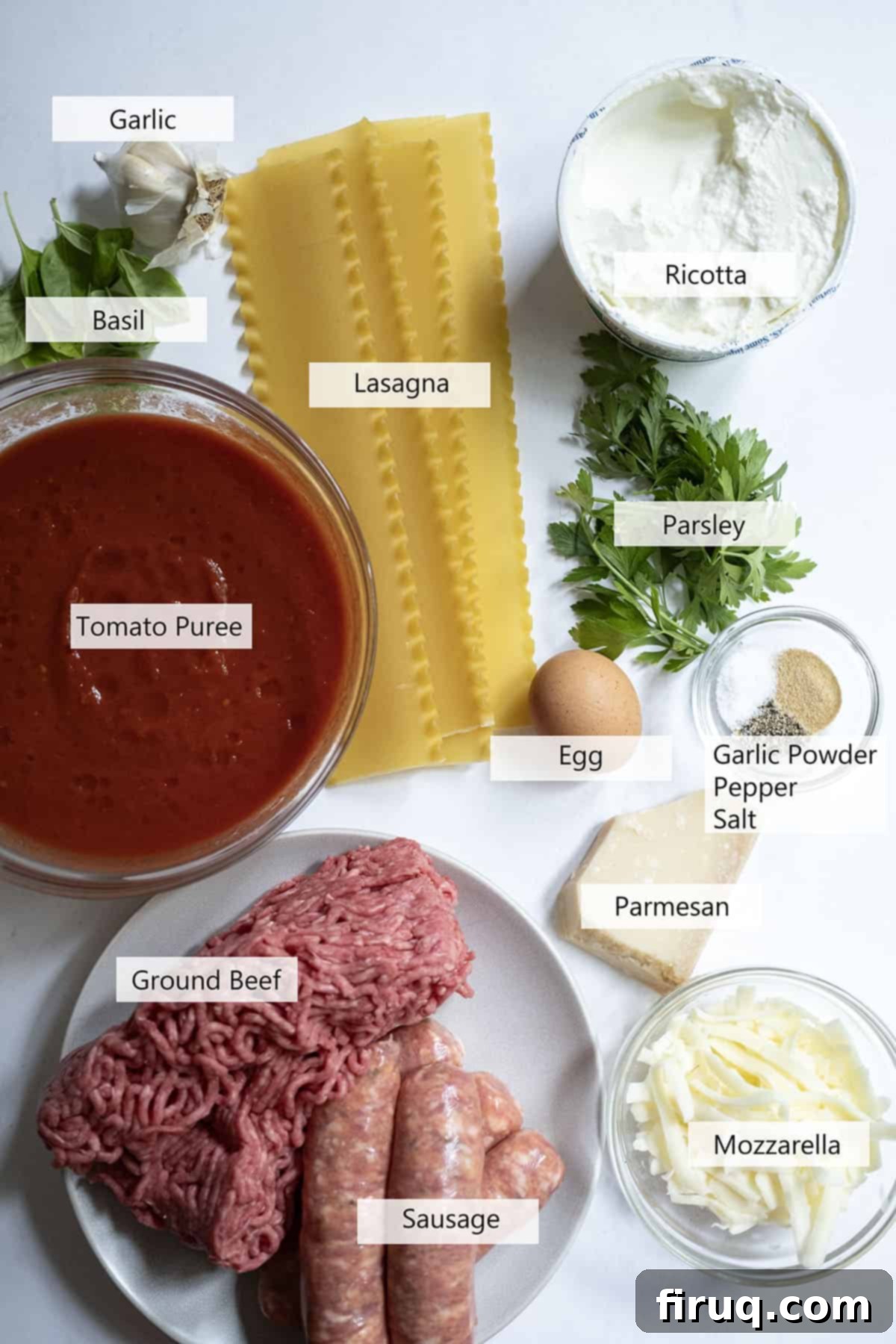
- Ground Beef and Sausage: We swear by a 50/50 blend of sweet Italian sausage and 80/20 ground beef. The sausage, removed from its casing, adds a nuanced flavor profile that truly makes the meat sauce shine. The 80/20 ground beef provides enough fat for flavor without making the sauce overly greasy. For a more personalized touch, you can even make your own sausage using our Homemade Italian Sausage Seasoning with ground pork. If you prefer, using solely ground beef is also a perfectly acceptable option.
- Ricotta: Full-fat, whole milk ricotta is essential for a creamy, rich texture. We often opt for Trader Joe’s ricotta, which offers excellent quality without the higher price tag of some gourmet brands like BelGioso. This forms the heart of our Ricotta Filling, a versatile base that you’ll want to keep on hand for other Italian dishes.
- Tomato Puree: For a smooth, consistent sauce, tomato puree is our go-to. If you prefer to use whole plum tomatoes, simply blend them with an immersion blender until smooth to achieve a similar texture and vibrant tomato flavor.
- Tomato Paste: This concentrated ingredient is crucial for developing a deep, complex tomato flavor. The secret lies in caramelizing the tomato paste at the base of your sauce. This process enhances its sweetness and umami, contributing significantly to the ragù’s richness.
- Mozzarella: We incorporate mozzarella into two key areas: a portion is mixed into the ricotta filling for added creaminess and cheesiness throughout the layers, and the remaining mozzarella is generously sprinkled on top to create that irresistible golden, bubbling crust.
- Lasagna Noodles: Forget those “no-boil” or pre-cooked noodles! For the best texture and authentic taste, we always use dried lasagna noodles that require a brief pre-boil. Boiling them for just 5-6 minutes ensures they are pliable enough to layer but won’t become mushy during baking. If you have access to fresh lasagna sheets, even better! Fresh pasta doesn’t require pre-boiling, saving you a step.
*Please see the recipe card below for more information on the exact quantities of ingredients.
Step-by-Step Guide to Making Authentic Italian Lasagna
Crafting a truly homemade authentic Italian lasagna involves several distinct steps, but the beauty of this dish is its flexibility. Many components can be prepared in advance, and the assembled lasagna can even wait in the fridge for a day before baking. This makes it a fantastic option for entertaining or busy weeknights!
If you’re in a hurry for another delicious baked pasta, our Authentic Italian Baked Ziti offers a quicker prep time without sacrificing flavor.
Preparing the Ricotta Mixture
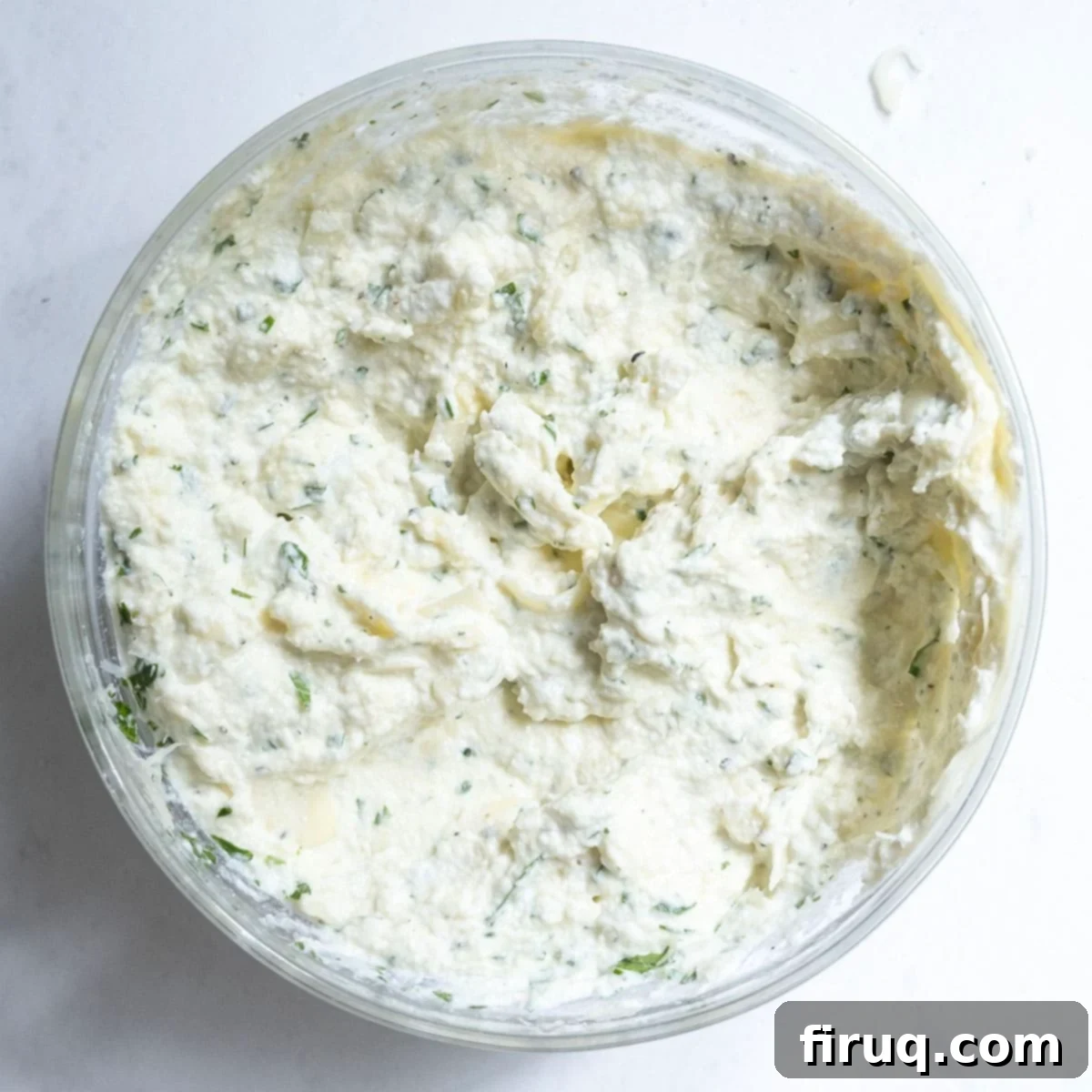
Step 1: In a large bowl, combine the whole milk ricotta with grated Parmesan cheese, a portion of the mozzarella, garlic powder, fresh chopped parsley, one egg, salt, and black pepper. The egg acts as a binder, helping the ricotta hold its structure and preventing it from becoming too watery. Once thoroughly combined, cover the bowl tightly with plastic wrap and store it in the refrigerator. This step can be done a day in advance to save time.
*Top Tip: Preparing your ricotta mixture a day ahead allows the flavors to meld beautifully, enhancing the overall taste of your lasagna.
Crafting the Rich Meat Sauce for Lasagna (Ragù)
A truly authentic Italian lasagna hinges on a flavorful meat sauce. This ragù provides the savory backbone for the entire dish.
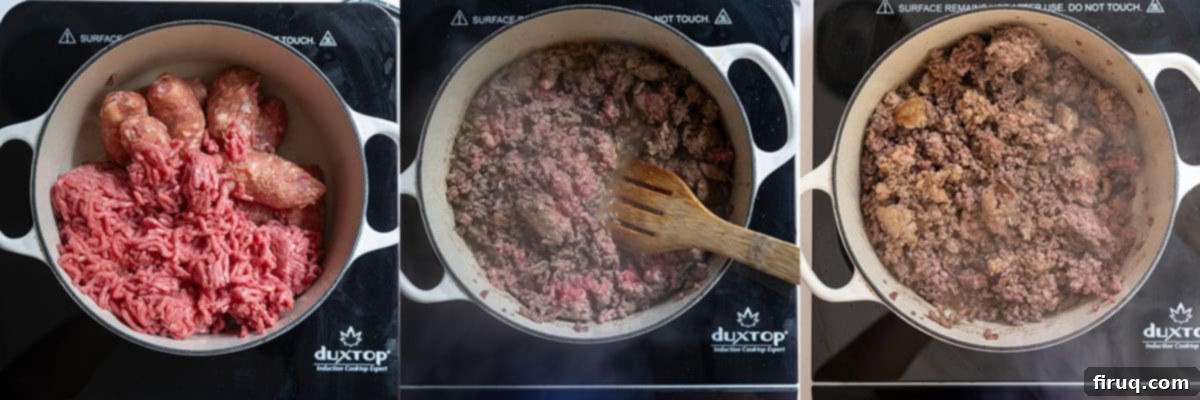
Step 2: Begin by placing a large pot or Dutch oven over medium-high heat. Add your ground beef and sweet Italian sausage (removed from casings). Allow the meat to sit undisturbed for about two minutes; this helps create a beautiful sear and develops flavor. Then, use a wooden spoon to break apart the meat into smaller pieces. Continue to cook, stirring occasionally, until the meat is thoroughly browned and no pink remains. Once cooked, remove the meat with a slotted spoon, reserving it in a separate bowl. Carefully drain any excess liquid or fat from the pot, leaving behind just a small amount for the next step.
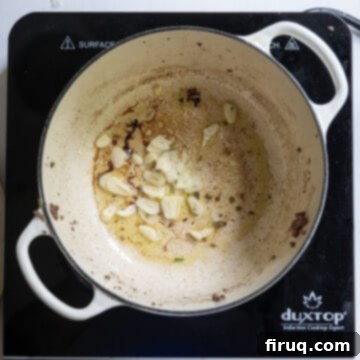
Step 3: Reduce the heat to medium. Add a generous drizzle of olive oil to the pot, then toss in the sliced garlic. Sauté the garlic for 1-2 minutes, stirring constantly, until it becomes wonderfully fragrant and lightly golden. Be careful not to burn it, as burnt garlic can turn bitter.
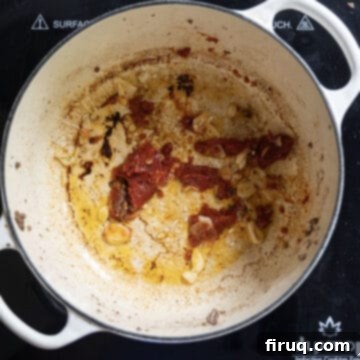
Step 4: Add the tomato paste to the pot with the fragrant garlic. Stir it well to combine with the olive oil and garlic. Allow the tomato paste to cook for 2-3 minutes, stirring occasionally, until it darkens slightly and caramelizes. This crucial step deepens the tomato flavor, making the sauce more robust and contributing to a richer, thicker ragù, essential for a satisfying homemade lasagna.
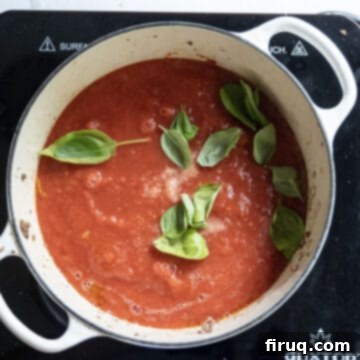
Step 5: Pour the tomato puree into the pot, along with the fresh basil leaves and salt. Stir everything thoroughly to combine all the flavors. Bring the sauce to a gentle simmer, allowing the ingredients to begin marrying together. This initial simmer ensures the basil and salt are well distributed.
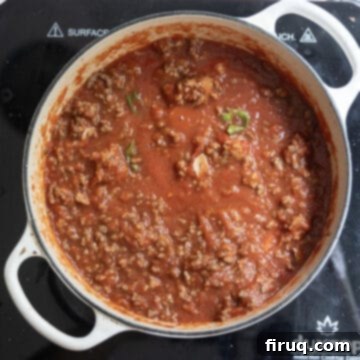
Step 6: Return the browned meat to the pot with the simmering sauce. Stir everything together and bring the sauce back to a gentle simmer. Allow the sauce to simmer, uncovered, for a minimum of 1 hour. This extended simmering time is crucial for the flavors to fully develop, deepen, and for the sauce to thicken to the perfect consistency needed for a robust lasagna. A thinner sauce can lead to a watery, messy lasagna.
Perfecting Your Lasagna Noodles
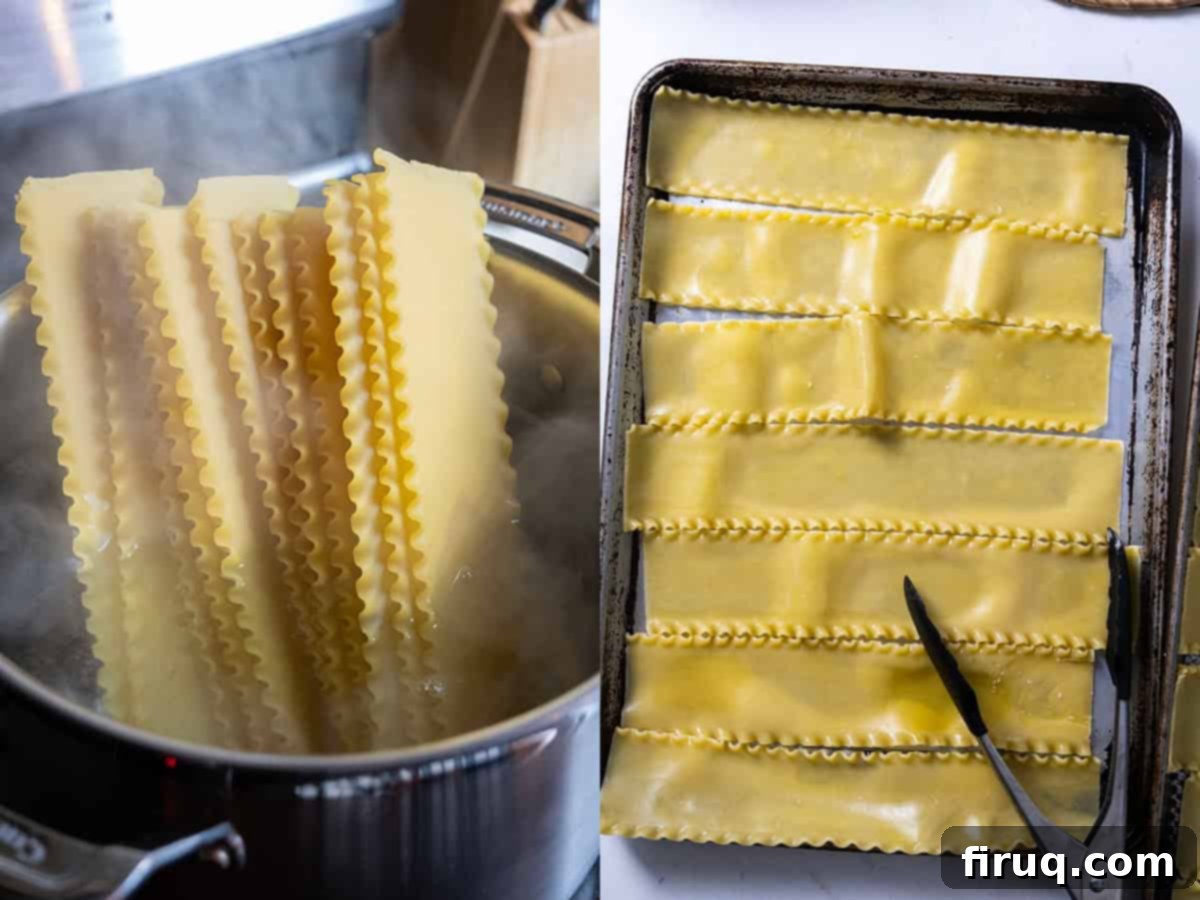
Step 7: While your flavorful meat sauce is simmering, it’s time to prepare the lasagna noodles. Bring a large pot of water to a rolling boil. It’s crucial to heavily salt the water, much like you would for any pasta, as this is your only opportunity to season the noodles themselves. Add your dried lasagna noodles to the boiling water and cook them for exactly 5 minutes. This partial cooking ensures they are pliable for layering but will finish cooking perfectly in the oven without becoming mushy.
Step 8: Once boiled, carefully strain the noodles in a colander. Immediately transfer them to a baking tray that has been generously greased with olive oil (as pictured above). Arrange them in a single layer, ensuring they don’t overlap too much. Allow them to cool slightly. The olive oil prevents them from sticking together, which can happen very quickly.
Helpful Hint for Boiling Lasagna Noodles: Dried lasagna noodles tend to stick together almost instantly after being strained. To combat this, as soon as they are strained, give them a light drizzle of olive oil and immediately begin laying them flat on a greased tray. You’ll likely need more than one tray to accommodate all the noodles in a single layer, ensuring they cool properly and remain separate for easy layering.
Assembling Your Layers of Deliciousness
The layering process is where your homemade lasagna truly comes to life, building flavors and textures with each step.
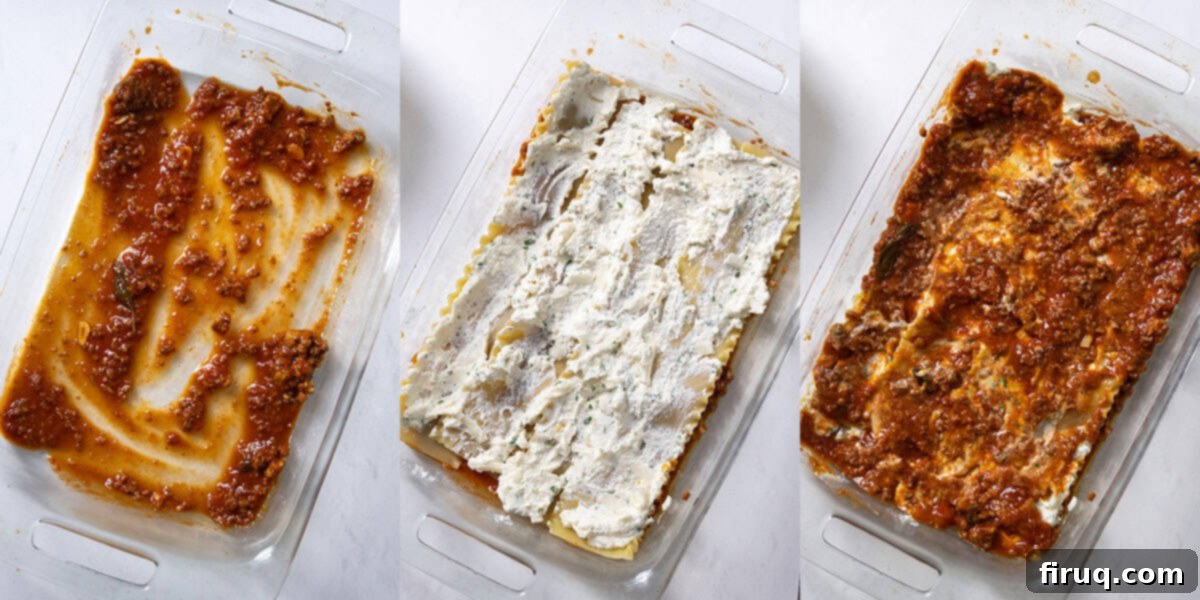
Step 9: Preheat your oven to 350℉ (175℃). To prevent the lasagna from sticking and to ensure a moist bottom layer, begin by spreading a thin layer of your rich meat sauce evenly across the bottom of your 9×13-inch baking dish.
Step 10: Carefully place a layer of lasagna noodles over the sauce. Typically, 4 pieces fit perfectly side-by-side in a standard baking dish. Next, spread an even layer of the prepared ricotta mixture over the noodles. Remember that you will be creating approximately 4 layers in total, so portion your ricotta accordingly.
Step 11: Ladle a generous amount of the meat sauce on top of the ricotta layer, spreading it gently to cover. Now, repeat the entire layering process, starting again with lasagna noodles, then ricotta, then meat sauce, until you have used all your pasta sheets. Aim for consistency in each layer for a beautifully even bake and presentation.
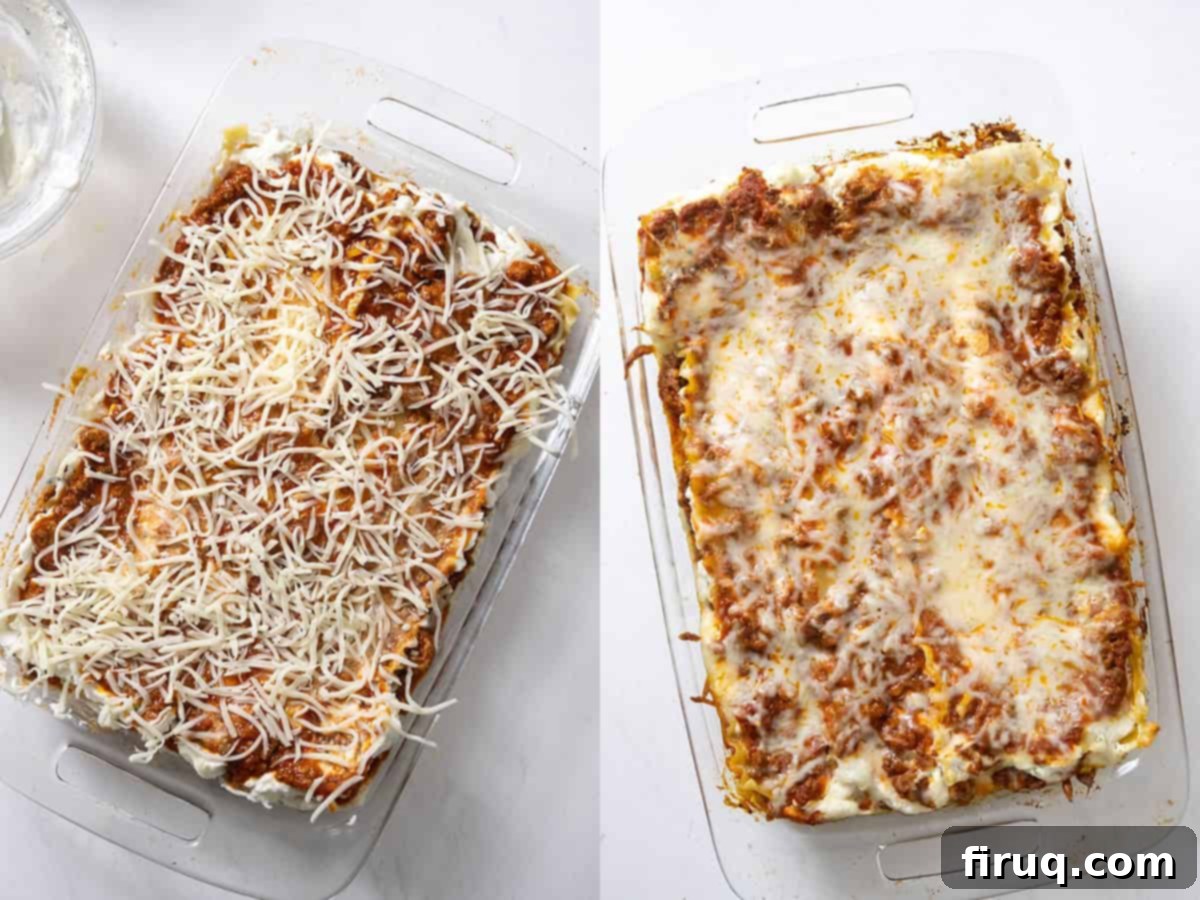
Step 12: For the grand finale, generously sprinkle the remaining mozzarella cheese over the very top layer of the lasagna. This will melt into a golden, bubbly crust that is simply irresistible.
Step 13: Place the assembled lasagna into your preheated oven and bake for 30-35 minutes, or until the cheese is melted, golden brown, and bubbling around the edges. Once baked, remove the lasagna from the oven and, crucially, allow it to rest for 15-20 minutes before attempting to serve. This resting period allows the layers to set properly, ensuring clean, beautiful slices that won’t fall apart when cut.
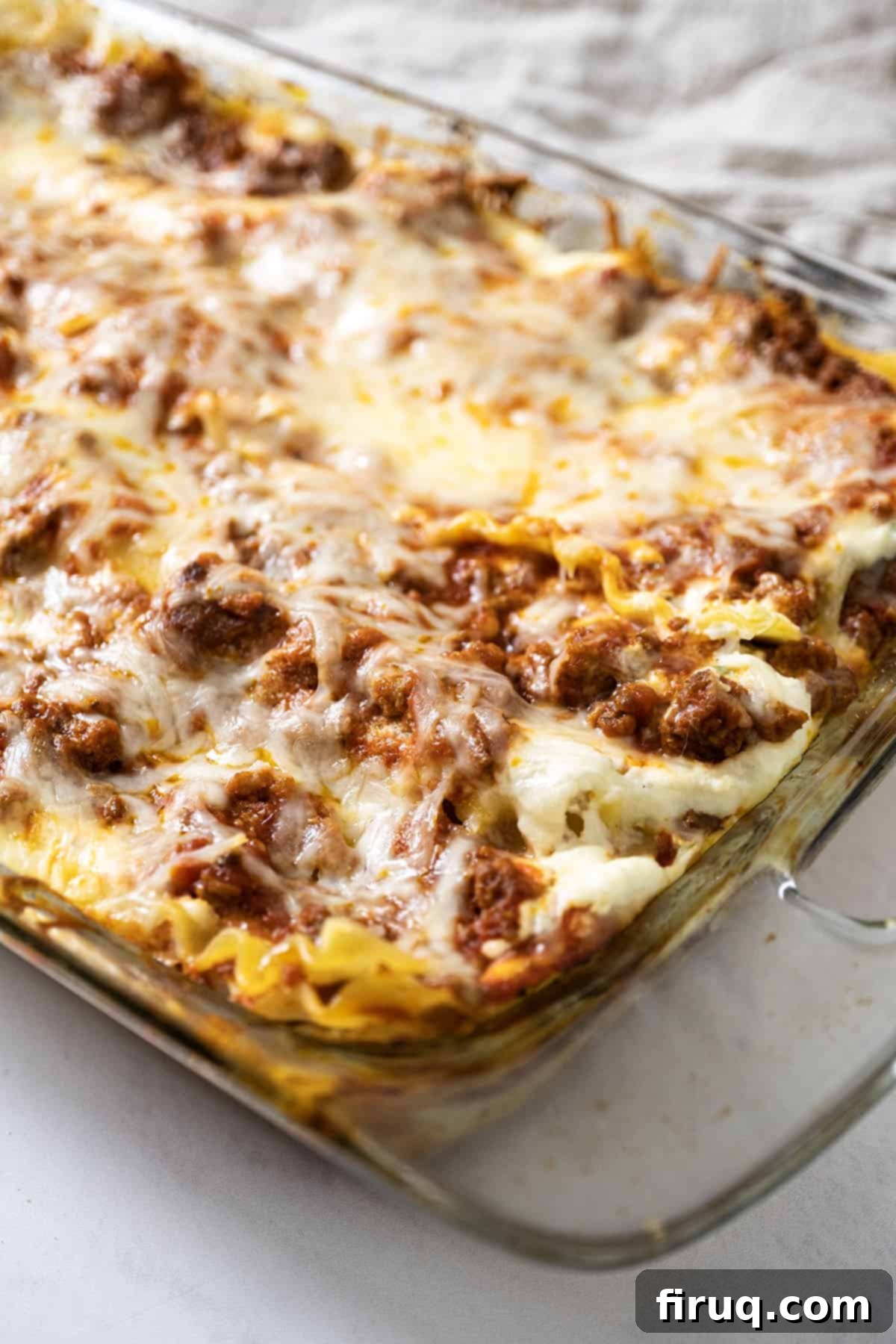
Expert Tips for the Best Authentic Italian Lasagna
Achieving a truly exceptional homemade lasagna requires a few key insights. These pro tips will help you avoid common pitfalls and ensure your dish is perfect every time:
- The meat sauce (ragù) absolutely needs to simmer for at least 1 hour to properly thicken. This extended cooking time not only allows the flavors to deepen and meld but also reduces the liquid content, preventing a watery lasagna that will collapse when served. Patience here is key for a robust, well-structured dish.
- When carefully layering the lasagna, make it a point to spread the meat sauce generously and evenly across all the edges of the pasta sheets. This is crucial to prevent the noodles from drying out and crisping up unattractively during baking, ensuring every bite is moist and tender.
- To make your cooking day less stressful, consider preparing the ragù a day or two in advance and storing it in the refrigerator. Even better, make a larger batch and freeze it for up to 3 months. This pre-preparation is a game-changer for busy schedules.
- Once the lasagna is out of the oven, resist the urge to cut into it immediately. Allow it to cool and rest for at least 15-20 minutes before serving. This vital cooling period gives the layers, especially the cheese and ricotta, time to set and firm up, ensuring that your beautiful slices hold their shape and don’t fall apart.
Make Ahead and Freezing Instructions for Ultimate Convenience
One of the many benefits of this classic Italian lasagna recipe is its excellent make-ahead and freezing potential, perfect for meal prepping or preparing for large gatherings.
How to Make Ahead: You can prepare both the seasoned ricotta mixture and the meat sauce a day or two in advance and store them separately in the refrigerator. For maximum convenience, you can even assemble the entire tray of lasagna up to two days before you plan to bake it. Just cover it tightly with plastic wrap and keep it refrigerated. This significantly reduces stress on the day of serving.
How to Freeze: To freeze an entire lasagna, assemble it in an aluminum half-tray – a disposable option is ideal for freezing and baking. Crucially, do NOT bake it before freezing. Once assembled, wrap the tray first in plastic wrap, then securely in aluminum foil. This double layer protects against freezer burn. It can be stored in the freezer for up to 3 months. When you’re ready to bake, remove the frozen tray from the freezer and transfer it to the refrigerator 24 hours ahead of time to allow it to thaw slowly. This same make-ahead and freezing process works wonderfully for our Italian Stuffed Shells with Meat Sauce and Ricotta as well.
When baking a lasagna that has been assembled and refrigerated or thawed from frozen, bake it covered with aluminum foil for the first 30 minutes. Then, remove the foil and continue baking for another 20-30 minutes, or until it’s heated through, bubbling, and the top is golden brown.
What to Serve with Your Authentic Italian Lasagna
While authentic Italian lasagna is undoubtedly a hearty and filling dish on its own, it’s rarely served alone in our family! A traditional Italian spread always includes complementary dishes to complete the meal. Here are some of our favorite pairings:
Meats: We often accompany our lasagna with additional savory meats. Consider serving Authentic Italian Braciole, slow-simmered and incredibly tender, or classic Classic Italian Fried Meatballs, which are always a crowd-pleaser. Our Italian Ring Sausage (Chevalatta) also offers a delightful peppery contrast.
Vegetables: To balance the richness of the pasta, fresh greens are a must. Sautéed Rapini with Garlic offers a wonderful bitter note, while our Italian Cabbage Recipe or Italian Lacinato Kale Recipe (Tuscan) provide earthy flavors and vibrant color.
Salad: A crisp, refreshing salad is essential. A robust Caesar salad with homemade Traditional Caesar Dressing and crunchy Homemade Italian Parmesan Croutons is always a hit. For something lighter, a simple spring mix salad tossed with our zesty Lemon Basil Vinaigrette is perfect.
Poultry: If you’re looking for classic Italian chicken dishes to serve alongside your lasagna, consider Fennel Chicken Thighs in Red Wine for a deeply savory option, or the elegant Restaurant-Style Chicken Francese for a brighter, lemony accompaniment.
Authentic Italian Lasagna: Your Questions Answered
It truly depends on the region of Italy! In the Southern regions, particularly around Naples, ricotta is a very common and beloved ingredient in lasagna, lending it a creamy, rich texture. This particular recipe mirrors the Southern Italian style. However, in Northern Italian cities like Bologna, a smooth béchamel sauce is traditionally used instead of ricotta, offering a different, yet equally delicious, creamy element.
Traditional lasagna, especially in the Southern Italian style, is typically constructed with alternating layers of lasagna noodles, a richly seasoned ricotta cheese mixture, and a hearty meat sauce (ragù). These layers are repeated several times, and the entire dish is then topped with a final generous layer of mozzarella and often some grated Parmesan cheese before baking to golden perfection.
For optimal presentation and structural integrity, a lasagna should ideally have 3 to 4 distinct layers. Fewer than 3 layers can make the lasagna appear too flat, almost like a pancake, and lack the desired textural contrast. Conversely, exceeding 4 layers can make it excessively tall and difficult to manage, both in the baking dish and when attempting to serve neat, individual portions.
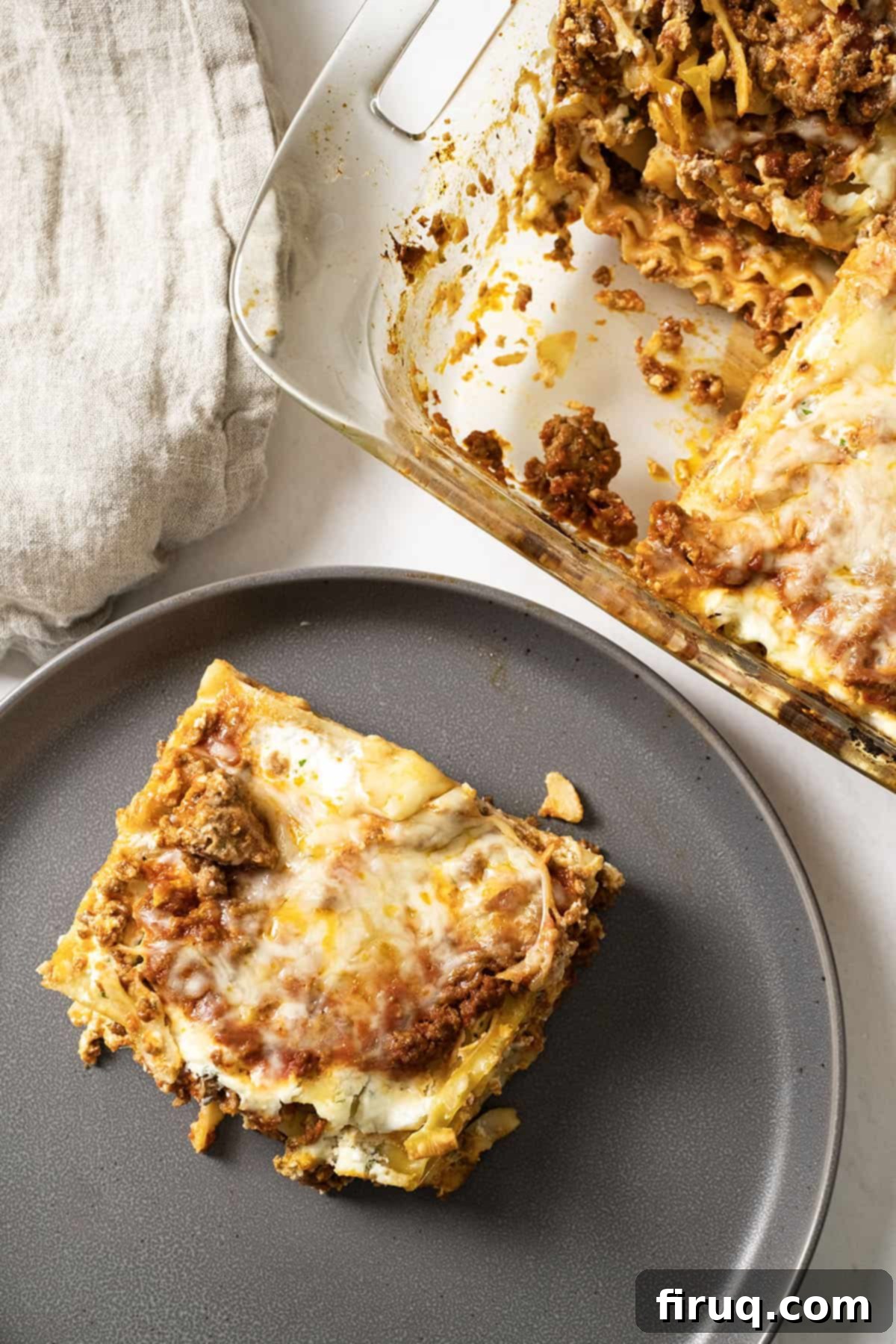
More Hearty Family-Style Italian Recipes
If you loved this homemade Italian lasagna, you’re sure to enjoy these other family-style dishes that are always a hit in our kitchen. They bring the same warmth and authentic flavors to your table:
- Authentic Italian Sunday Sauce
- Spicy Chicken Riggies
- Creamy Chicken Parmesan Pasta
- Creamy Brie Pasta
We absolutely love hearing from you! Please leave a comment and a star rating below in the recipe card if you try our recipes. Your feedback means a lot. Feel free to tag us on Instagram @vindelgiudice to share your culinary creations!
📖 Recipe
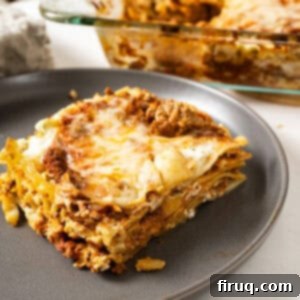
Authentic Italian Lasagna
Vincent DelGiudiceEquipment
- 1 9×13 baking dish
- 1 large pot
Ingredients
- 1 lb lasagna noodles
- 1 lb ground beef (80/20 preferred)
- 1 lb sweet Italian sausage, casings removed
- 28 oz can tomato puree
- 2 tablespoon tomato paste
- 3 cloves garlic, thinly sliced
- 4 fresh basil leaves
- 1 cup shredded mozzarella cheese (for topping)
- 1 teaspoon salt (for sauce)
- 2 tablespoon extra virgin olive oil
Ricotta Filling
- 15 oz whole milk ricotta cheese
- ½ cup shredded mozzarella cheese
- ½ cup grated Parmesan cheese
- 1 large egg
- 3 tablespoon fresh chopped parsley
- ½ teaspoon salt
- ½ teaspoon black pepper
- 1.5 teaspoon garlic powder
Instructions
- In a large bowl, combine all of the ingredients specified for the seasoned ricotta filling. Stir until well combined and smooth. Cover the bowl securely with plastic wrap and store it in the refrigerator until ready to assemble the lasagna.
- To make the meat sauce, bring a large pot or Dutch oven to medium-high heat. Add the ground beef and sweet Italian sausage. Allow the meat to sear for two minutes before breaking it apart with a wooden spoon. Continue cooking and stirring occasionally until the meat is completely browned and fully cooked through. Remove the cooked meat with a slotted spoon and set it aside in a bowl. Carefully pour off any excess liquid or fat from the pot.
- Reduce the heat to medium. Add the olive oil to the pot, followed by the sliced garlic. Sauté the garlic for 1-2 minutes until it’s fragrant and lightly golden (do not burn). Stir in the tomato paste, combining it thoroughly with the garlic and oil. Let it cook for approximately 1 minute, stirring occasionally, to caramelize the tomato paste, deepening its flavor.
- Pour the tomato puree into the pot, then add the fresh basil leaves and salt. Stir well to integrate all the ingredients. Bring the sauce to a gentle simmer. Once simmering, add the reserved cooked meat back into the pot and stir to combine. Allow the meat sauce to simmer, uncovered, for a minimum of 1 hour, or up to 2 hours, stirring occasionally. This long simmer develops a rich flavor and ensures the sauce thickens appropriately.
- While the sauce is simmering, prepare your lasagna noodles. Bring a separate large pot of water to a rolling boil and heavily salt it. Add the dried lasagna noodles and boil for 5 minutes. Drain the noodles in a colander, then immediately lay them flat on baking trays greased with olive oil to prevent them from sticking together. Allow them to cool slightly.
- Preheat your oven to 350℉ (175℃). To assemble the lasagna, spread a thin layer of meat sauce across the bottom of a 9×13-inch baking dish. Arrange a layer of 4 lasagna noodles over the sauce. Spread about one-quarter of the ricotta mixture evenly over the noodles. Then, ladle another generous amount of meat sauce on top of the ricotta. Repeat this layering process – noodles, ricotta, meat sauce – three more times, until you run out of lasagna noodles. On the very top layer, sprinkle generously with the remaining shredded mozzarella cheese. Bake in the preheated oven for 30-35 minutes, or until the cheese is melted, golden brown, and bubbly.
- Once baked, remove the lasagna from the oven and let it rest for 15-20 minutes before slicing and serving. This crucial resting time allows the layers to set, ensuring neat and intact portions.
Notes
- The sauce needs to simmer for at least 1 hour to thicken. If the sauce is too thin, the lasagna will fall apart when you serve it.
- When layering the lasagna, make sure to spread the sauce evenly on all the edges of the lasagne so that they don’t crisp up.
- Make the ragu a day or 2 in advance and store it in the refrigerator, or make it in advance and store it in the freezer for up to 3 months.
- Let the lasagna cool for at least 15 minutes before serving so that it has time to set and doesn’t fall apart.
